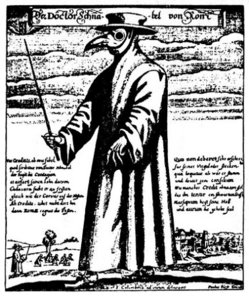After bubonic plague reached Europe in the 14th century, major cities such as Venice enacted strict quarantines intended to keep out infected, shipborne rats. The cities would remain free of the disease for a time, but every decade or so, the plague returned. People have presumed that infected rats had sneaked back into town.
Challenging that assumption, computer modeling of how bubonic plague spreads from rats to people now suggests that the disease never went away. It probably persisted in the rat populations living in the cities, say Matthew J. Keeling and Chris A. Gilligan, both of Cambridge University in England.
Beyond suggesting that bubonic plague can lurk within rat populations for years without causing human epidemics, Keeling and Gilligan's work published in the Oct. 19 NATURE comes to the counterintuitive conclusion that killing rats may sometimes exacerbate plague outbreaks among people.
"There's a lot here for public health officials to think about," says Ben Bolker of the University of Florida in Gainesville, who also models infectious diseases.
Before looking into the plague for this new work, says Keeling, he felt the disease was of only historical interest. Yet bubonic plague has made a comeback, he notes. In the 1990s, it struck Africa and India, and scientists found that the bacterium responsible has developed antibiotic-resistant strains.
Past efforts to model bubonic plague treated it as primarily a human disease, which is inappropriate, says Keeling. "It's a rodent disease that occasionally infects humans," he explains. The fleas that transmit the plague feed upon people only when the disease wipes out so many rats that the insects turn to another food source.
By showing human outbreaks about every decade, the computer analysis by Keeling and Gilligan mirrors historical records of plague epidemics in medieval Europe. At the same time, the model reveals that in its hypothetical city, bubonic plague never disappears completely from the rat population.
A key feature of the new model, says Keeling, is that it treats the rat population as a collection of many subpopulations having limited interactions with each other. Many scientists today consider such an approach more realistic than modeling a single, large rodent population.
In their model, Keeling and Gilligan found that bubonic plague can persist in subpopulations of rats in which many of the animals are immune to the disease. In subpopulations in which almost all the rats are vulnerable, an epidemic can wipe out all the animals and then spread to people.
The new model suggests that the best way to prevent bubonic plague in people is to stop its spread in rats, a strategy that public health officials have begun to embrace, says Keeling. But once human cases appear, it's too late to simply kill rats, the model indicates.
"If you ever got an outbreak in a large city in the developed world, there would probably be a strong public opinion wanting to kill the rodents, which isn't an effective strategy," says Keeling. "This will just release many infected fleas."
That could worsen a human epidemic. So, Keeling suggests that insecticides are a more appropriate response once bubonic plague appears in people.
Bolker suggests that the investigators could make their model more realistic with better data on the ecology of rats. Keeling agrees but adds that there's very little relevant data available.
Keeling and Gilligan note that today rat populations infected with bubonic plague still exist in rural regions of the United States. The researchers hope to extend their model to determine the circumstances under which the disease could spread to rats in U.S. cities.
COPYRIGHT 2000 Science Service, Inc.
COPYRIGHT 2000 Gale Group


